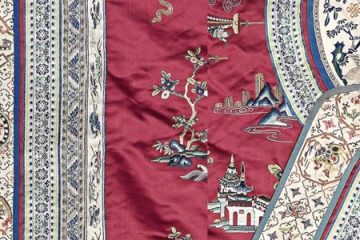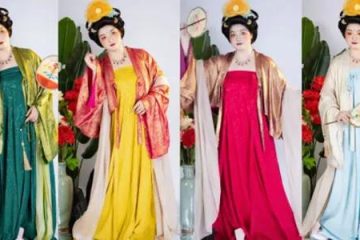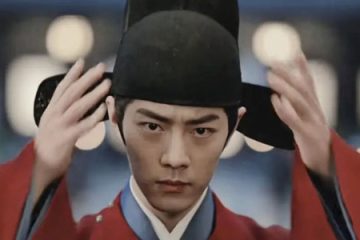Unveiling the Enigmatic Headcovers of Ancient Chinese Ladies

Before, in the discussion of “Is the Fujin on the South Korean banknote from China?”, we mentioned that the headscarf worn by men is called “fujin”. Does anyone wonder what kind of headdresses ancient Chinese women wore? In fact, in the ancient costume drama Jia Ye (《家业》) starring Yang Zi, the styling where the actress wears a white veil is something worth talking about.
I. Different Ways of Wearing the Head Cover
Some people say that this kind of attire resembles the appearance of “Guanyin”, and there is actually some truth to it. The style worn by Yang Zi is somewhat similar to the “gaitou (盖头, head cover)” depicted in Song Dynasty paintings, and it also resembles the “fujin (幅巾)” that was popular among women in Ming dynasty clothing.
However, in terms of the way it is worn, it doesn’t cover the forehead. Let’s first talk about the head cover. The head cover refers to the “square piece of purple silk” that can cover half of the body. It is just a square piece of cloth that can be directly draped over the head, and then one can go out.

Mr. Shen Congwen also verified that the “gaitou” was indeed a commonly popular head accessory among women in the Song Dynasty. There is currently no conclusive opinion on the relationship between the headscarf in the Ming Dynasty and the head cover in the Song Dynasty.
In the drama Under The Moonlight with the background of the Ming Dynasty-style makeup and attire, the “head cover” also appears. It can be seen that the head cover is more like a square piece of cloth draped over the head. When working women use it, for the sake of convenience, they can also tie up a part of it.

The fujin that was popular during the Ming Dynasty is actually a headscarf with a curved hood and straps. At first, it was mostly worn by men. Later, it was also used by women who dressed in men’s clothing (during the late Ming Dynasty). The inheritance relationship between the fujin, the head cover, and the Hu-style hood needs further investigation.
However, considering that it was mainly used by men, it is more likely to be associated with the futou. Or it might just be a difference in name. Therefore, the author speculates that women wore the “gaitou”, while men wore the “fujin”. As for whether women continued to use the head cover in the Song Dynasty style in their daily lives, it remains unknown.

The fujin is a kind of item that rarely appears in domestic ancient costume dramas. However, it often shows up in Korean dramas. Maybe because the fujin frequently appears in Korean dramas, people have a preconceived notion that it is a Korean product.
In fact, the fujin is from China, and its style has basically remained unchanged. It seems rather strange that this fujin, which is a quite popular accessory, rarely appears in domestic ancient costume dramas set in the Ming Dynasty. Is it because they are afraid of being associated with Korean dramas? 🤔

II. The Fujin and Confucian Culture
In China, the earliest mention of the “fujin” is in the Biography of Zheng Xuan in the Book of Later Han, which states, “Zheng Xuan did not wear the court attire but met guests with a fujin instead.” However, the early fujin was rarely seen in paintings and can be understood as a kind of head accessory similar to the “jinpa (巾帕)” for wrapping the head.
Generally speaking, the style of the fujin that we now recognize became a widely popular head ornament during the Song and Ming dynasties. As verified by cultural relics from the Ming Dynasty, it is usually made of silk fabric with both the length and width are three chi. (about 93.3cm)

The wearing method is referred to as follows: When wearing the fujin, wrap it around the back of the head from the forehead to cover the hair, and then tie it tightly. According to the records, “Pass it over the top of the head from the outside of the towel and tie it, and let the ends hang down.” That is, after tying the two straps at the back of the head, the straps should hang down in the front. Most of the length of the fujin in Chinese apparel reaches the shoulders, and there are also quite a few that can reach down to the back.

During the Song and Ming dynasties, the fujin was closely connected with Confucian culture and became a necessary item for solemn occasions such as sacrifices and ancestor worship. Many great Confucian scholars showed themselves wearing fujin, traditional deep robes, and square shoes when paying homage to their ancestors and Confucius, expressing their respect for and inheritance of traditional culture.

At first, the fujin was highly regarded as a headwear for the literati and aristocratic class. By the end of the Ming Dynasty, with the rise of the fashion of women wearing men’s clothes, wearing the fujin gradually became a new trend in women’s clothing, showing the elegant side of women.
It even appeared in various Taoist water and land paintings and paintings of beautiful ladies. For example, Liu Rushi liked to wear the fujin. She believed that it not only reflected the wearer’s attitude towards fashion but also demonstrated the gentle and refined temperament like that of a scholar.

The Korean fujin was influenced by the fujin of the Ming Dynasty in China. However, it was mostly worn by children and students, and was rarely worn by scholar-officials.

Our current impression of “Guanyin” mostly comes from works such as water and land paintings or statues in the style of the Song and Ming dynasties. The image of the White-Clothed Guanyin and the related images of pious woman mostly wear a head cover or a fujin on their heads. This is also a reflection of the way women dressed in the Song and Ming dynasties. As the saying goes, the materials for clothing in paintings also come from real life.

Summary
After looking at all this, do you prefer the fujin worn by men or the gaitou worn by women in traditional Chinese clothing? These headwear items in traditional Chinese clothing are quite rare precisely because they are not well-known. Although they are an important part of Chinese traditional clothing culture, they are always “overlooked“. In so many ancient costume dramas over the years, the fujin has only appeared in a few dramas, and there are very few shots of it. It has to be said that the promotion of clothing in Chinese films and TV shows is still insufficient!



0 Comments